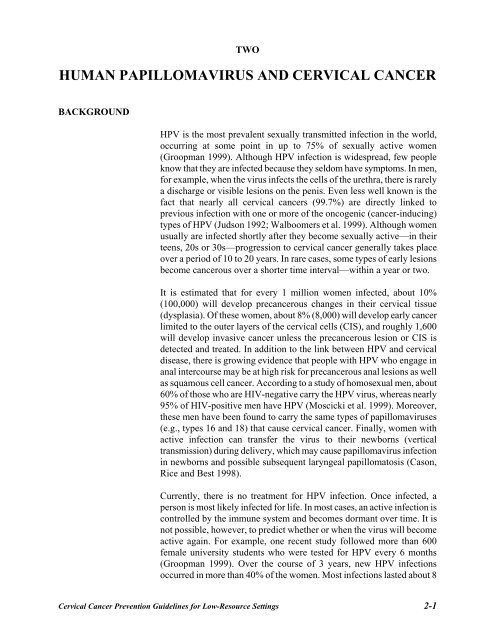Reference Manual - IARC Screening Group
Reference Manual - IARC Screening Group
Reference Manual - IARC Screening Group
You also want an ePaper? Increase the reach of your titles
YUMPU automatically turns print PDFs into web optimized ePapers that Google loves.
TWOHUMAN PAPILLOMAVIRUS AND CERVICAL CANCERBACKGROUNDHPV is the most prevalent sexually transmitted infection in the world,occurring at some point in up to 75% of sexually active women(Groopman 1999). Although HPV infection is widespread, few peopleknow that they are infected because they seldom have symptoms. In men,for example, when the virus infects the cells of the urethra, there is rarelya discharge or visible lesions on the penis. Even less well known is thefact that nearly all cervical cancers (99.7%) are directly linked toprevious infection with one or more of the oncogenic (cancer-inducing)types of HPV (Judson 1992; Walboomers et al. 1999). Although womenusually are infected shortly after they become sexually active—in theirteens, 20s or 30s—progression to cervical cancer generally takes placeover a period of 10 to 20 years. In rare cases, some types of early lesionsbecome cancerous over a shorter time interval—within a year or two.It is estimated that for every 1 million women infected, about 10%(100,000) will develop precancerous changes in their cervical tissue(dysplasia). Of these women, about 8% (8,000) will develop early cancerlimited to the outer layers of the cervical cells (CIS), and roughly 1,600will develop invasive cancer unless the precancerous lesion or CIS isdetected and treated. In addition to the link between HPV and cervicaldisease, there is growing evidence that people with HPV who engage inanal intercourse may be at high risk for precancerous anal lesions as wellas squamous cell cancer. According to a study of homosexual men, about60% of those who are HIV-negative carry the HPV virus, whereas nearly95% of HIV-positive men have HPV (Moscicki et al. 1999). Moreover,these men have been found to carry the same types of papillomaviruses(e.g., types 16 and 18) that cause cervical cancer. Finally, women withactive infection can transfer the virus to their newborns (verticaltransmission) during delivery, which may cause papillomavirus infectionin newborns and possible subsequent laryngeal papillomatosis (Cason,Rice and Best 1998).Currently, there is no treatment for HPV infection. Once infected, aperson is most likely infected for life. In most cases, an active infection iscontrolled by the immune system and becomes dormant over time. It isnot possible, however, to predict whether or when the virus will becomeactive again. For example, one recent study followed more than 600female university students who were tested for HPV every 6 months(Groopman 1999). Over the course of 3 years, new HPV infectionsoccurred in more than 40% of the women. Most infections lasted about 8Cervical Cancer Prevention Guidelines for Low-Resource Settings 2-1
















